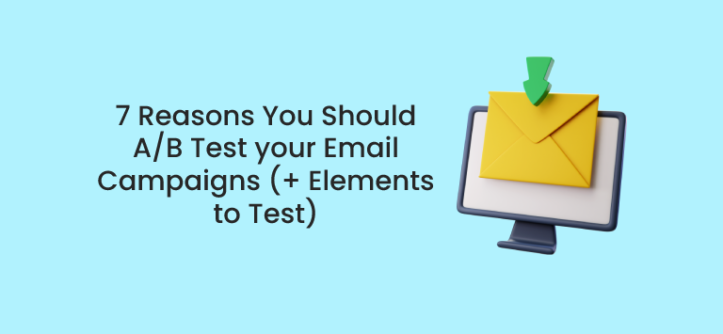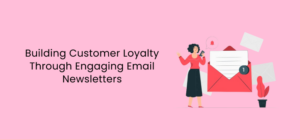Email marketing is one of the oldest and most effective internet marketing channels. Over the past decade, despite the emergence of new technologies, research shows it has returned the highest ROI for marketers and businesses alike. For every dollar spent on email marketing, you can earn up to $36 ROI.
And that is not all. Email marketing lets you stay in touch with your clients, engage them, and increase retention rates. It lets you personalize your customer experience, help customers learn more about your business, improve brand awareness, and drive more traffic to your website.
To reap all those benefits of email marketing, you must put in a lot of work. You need to know your target client, entice them with attention-grabbing subject lines, and offer them quality and relevant content. All this requires that you set goals, plan diligently, and utilize the right tools.
But to receive the most ROI and engagement from your marketing campaigns, you must ensure that your approach will pay off. And how do you achieve this? By doing A/B testing. A/B testing allows you to test your hypothesis on different elements of your email to see if they are indeed a good fit for the audience you’re looking to engage. And it has a lot of benefits.
In this article, we’ll share seven reasons why you should A/B test your email campaigns and what elements of your campaigns to test.
What is A/B Testing in Email Marketing?
A/B testing is a marketing experiment where you send two different variations (variants A and B) of an email to a segment of your audience to see which performs better.
When creating your two variants, A and B, you can focus on making the difference tiny or substantial. You can choose to use a different subject line/call to action or change the whole email content/design.
However, when conducting A/B testing, it’s best to focus on one element at a time. This will help you know which specific change made the difference.
When A/B testing your email campaigns, you need to have a goal in mind. That is, what you intend to achieve from your efforts. The goal can be to get your subscribers to open your email, click on your link or make a purchase.
Having a goal will let you know which element to test and how to measure performance. In the end, you’ll learn how to optimize your email marketing strategy and get the highest ROI.
7 Reasons you Should A/B Test your Email Campaigns
When running any marketing campaign, you need to take an approach that resonates with your audience. This is particularly vital in email marketing. Your prospects receive 10s of daily emails from businesses, including some from your competitors. The truth is they can’t read all those emails, let alone take action. They’ll be selective.
As a business or marketer, you want to be the one who gets selected every time. To reach that point, you need to be sure that your email will entice your customer. And you can’t be sure without A/B testing every email you send.
A/B testing allows you to make data-driven decisions. It prevents you from getting lost in prospects’ inboxes or flagged as spam. Testing will enable you to constantly send emails that address your client’s needs, build trust, and increases retention rates.
Here are seven more reasons you need to A/B test your emails:
To Increase the Open and Click-Through Rates
To stand out in your client’s inbox, your emails must be able to catch your audience’s attention. So it’s important to ensure it has elements, such as a call to action, that your clients can easily interact with – that is, open them and take action. A/B testing allows you to see how effective those elements can be in your campaigns.
The subject line is the first thing your clients see when you email them. It is also the deciding factor. If your subject line doesn’t resonate with the customer, they won’t open the email. And if they don’t do that, your efforts are wasted. Testing allows you to try out different subject lines and use the one with the one that results in more email openings.
Your click-through rates (CTR) are important when measuring how well clients respond to your promotions. When your email is opened, you earn impressions, but CTR shows how many people took action. A/B testing allows you to decide the best call-to-action messaging to use, how to design them, and where to place them.
To Boost your Conversion Rate and ROI
Testing your CTR and open rates allows you to drive more customers to your website. But it is not every day that all those visits result in sales or other conversion metrics. A/B testing will enable you to know which elements lead to higher CTR, higher conversions, and ultimately higher ROI.
A/B testing helps you identify the type of messaging your customers want and what emails generate more leads and sales. This will ensure that you constantly send emails that won’t just get opened but ones that will help you generate revenue and increase your ROI.
Finally, email A/B testing can tell you if you need to improve elements in your website. If your CTR is higher, but conversions are low, you should take steps to change your landing page, website UX, simplify your checkout process or tweak other elements of your site. For better results, you should also A/B test elements on your site.
To Improve Engagement With your Audience
One of the best ways to keep prospects in your sales funnel and retain existing customers is to keep them engaged. A/B testing allows you to identify strategies that will improve your engagements. You will be able to find ways to educate them more about your products/services and have them take incremental steps.
With A/B testing, you can identify the type of content your users prefer. For example, send two different email variants offering tutorials on how to use your product/service. Variant A should contain a link directing clients to your blog, and variant B should lead them to your YouTube channel. The first variant will be a written tutorial, and the second will be a video.
After the A/B test, you can tell what type of content your users prefer, which can help your email and content marketing strategy. Ultimately, this ensures you can generate content that drives engagement, CTR, and conversions.
Obtain Valuable Information About Your Audience Interests
A/B testing is multi-functional. In addition to telling you what type of email content your audience wants, it can tell you what they don’t like. You can gain useful information about your audience’s interest by how they react (or don’t) to your emails.
You can run a promotion offering 50% off, but if your emails aren’t crafted in a manner that will entice the reader, you will fail to generate sales. A/B testing can help you avoid this by improving how you prepare your copy and deciding which products/services to promote.
Let’s look at an example:
Your company has two products and wants to run a limited promotion on only one. A/B testing can help you figure out which product to put on sale. You can send two different email variants to a segment of your mailing list. Variant A will contain an offer for one product, and variant B a different one. After a few days, you can analyze the results and know which product your clients are more interested in. You can then run a whole campaign on that product.
Let’s say the product is $400, and you want to give your customer 25% off. A/B testing can help you choose a message that your audience will prefer. You can test two variants:
- A: Get 25% off Your Next Purchase!
- B: Get $100 off Your Next Purchase!
You will then use the winning one to run your campaign.
Save Time and Money
A lot of effort goes into running a successful email marketing campaign. A/B testing ensures that those resources don’t go to waste by making every email you send relevant to your user and have positive returns. Whether you want to drive traffic to your website or generate sales, A/B testing will help you implement the best strategy.
A/B testing will help you know which elements of your email campaigns you need to improve and how to relate to your audience. It enables you to save money and time in a straightforward way: you only run tests on a small segment of your subscribers before launching a campaign.
This saves you money as you won’t need to invest more in a campaign if the A/B testing shows that clients are responding to your marketing idea. Additionally, analyzing data from a small segment will usually take less time and give more accurate results.
A/B testing allows you to create campaigns that will return the highest ROI possible and prevent you from wasting money and time on strategies that wouldn’t work for your audience.
To Decrease Unsubscribe Rate
As a business, freelancer, or digital marketer, you will need to completely revamp your email marketing campaigns every once in a while. Maybe because a strategy you’ve been using needs to be updated as it is not returning expected results, or you want to launch a new campaign. Or you are even rebranding. All this may require that you make substantial changes that customers aren’t expecting. This can present serious risks, including losing subscribers.
A/B testing can help you reduce those risks in multiple ways. First, you’ll be able to tell just how many changes your customers are ready for, and second, how slowly you should make the changes. The results you get will help you create a strategy with the least negative effect on your email list.
A/B testing can also help you catch small mistakes before they become disasters. For example, you can tell if your copywriter included a joke in their copy that some of your clients found offensive and unsubscribed. Before you broadcast to the rest of your audience, you will know not to include that joke if you want to retain subscribers.
To Gain a Competitive Edge
Every marketing strategy always pays off when you take steps to stay ahead of competitors. Email marketing is no exception.
With almost 40% of ignoring email A/B testing, you can leverage this exercise to get more insights into your customer’s needs and offer what they’re missing elsewhere. A/B testing can help you gain a competitive edge.
By failing to A/B test their campaigns, competitors ignore users’ needs and push them away daily. You need to take them in and provide a safe house. And the first step in doing that is ensuring your emails are optimized to their specific needs.
Email Elements to A/B Test
Using the right email marketing tools, you can A/B test almost all the elements of your email copy, from your subject line down to your sign-off phrase. The type of element you test will usually depend on your goal.
If you want to sell something, putting much of your focus on increasing CTR using the best call-to-action messaging could pay off. And if you are looking to keep your readers informed, you will test what type of content to share with them.
Here are five elements you should test to ensure your emails help you accomplish your goals:
Subject Line
The subject line is the first thing your subscriber sees when you send them an email. It is the element that decides whether they will open your email. You will struggle to meet your email marketing goals if your email isn’t read.
Therefore, it is essential that you test different subject lines and settle on the one with the highest open rates.
Some variants you can test when running the subject line A/B test include:
Length: Some users prefer detailed subject lines others prefer short ones. A long subject line can give too much info, leading a subscriber to make a hasty decision to ignore your message. A short one can fail to deliver any message. Testing allows you to find the perfect length that can entice your users to open the email.
Word Order: How you arrange your words in the subject line, especially when running a competition, can shape your open rates. Ensure that you test different variants and settle with the one that earns you the most opens.
Here’s an example of a brand using two different word orders:
Call to Actions
You can test a different aspect of your call to action to ensure that you settle with the best copy that increases your CTR, drives traffic to your website, or increases sales. Simple tweaks to your call to action have the potential to create urgency, play on the audience’s emotions, and guide your prospects.
Some aspects you can test include:
The message: This is a copy of your call to action button. Before broadcasting your campaign, you can test which message the readers respond to—switching from generic CTAs like “Learn More” to “Show Me How” can bring massive differences.
Design: The way you present your CTA matters. Buttons or hyperlinks? If you choose a button, what colors should you use? A/B test to ensure your CTAs are well positioned and the design reflects your business’s branding.
The beauty of call-to-action buttons is you can use a couple of them in your copy. This will help your reader make decisions faster and keep them engaged. Here is an example:
Email Visuals and Design
You can’t afford to send generic, plain text emails if you want to keep your subscribers engaged with your content, look professional, and maintain brand consistency. Users want well-designed emails containing infographics that are easy to read or peruse.
Before launching an email campaign, take time to A/B test your email designs. Email marketing platforms will help you test different templates on your customers, and you can pick the best version.
But remember to only experiment with promotions or offers. You should keep your designs the same when sending your weekly/monthly newsletter or important communication like your invoices to clients so you can consistently generate positive cash flow for your business. These are essential aspects of your branding strategy; constantly changing them could confuse the audience.
Email Content
You can A/B test your email content to see what resonates best with your audience. Once you get your prospect to open your email, you have to do the hard job of convincing them to take action. And you will need the best content to achieve that.
There are many aspects of email content you can test. They include:
- Type of content: This will depend on your goals. For instance, if you want feedback, you should A/B test different types of surveys.
- Tone: The tone you adopt will depend on your brand, audience, and demographics. How you address Gen Z users will differ from how you address Boomers. You can A/B test how professional or personal you want to sound. Or how positive your tone should be.
- Length: How long should your copy be? The length of your email is important in helping you meet your objectives. Ensure that you A/B test whether your audience likes long-form or short-form copies.
Personalization
Consumers love personalization and demand it. One of the oldest personalization practices is addressing the recipients by their names. You can perform an A/B test to figure out the best position to place their names. Some brands prefer to include the recipient’s name in the subject line, while others reserve it for the email body. Testing allows you to know where to place the name in your copies.
But personalization has evolved past that stage. Today customers give brands too much data. If you have enough data on your clients, you should leverage it to create more tailored content.
Divide your audience into segments and only send emails that are most relevant to them. This is specifically important when you have a diverse customer base and want to reach all of them. Personalization allows you to market to each group according to their demands.
Ensure your A/B Testing is Successful
Running successful A/B testing doesn’t just happen. You need to take premeditated steps to avoid any loopholes. If you perform the wrong test ignoring the data you receive, you might ruin your email marketing campaign.
To avoid that, follow these tips:
- Know your end goal: This will help you create a hypothesis and show you what elements to test and how to test them.
- Prioritize: It’s impossible to test all the elements of your email. Choose the most important ones and test those first.
- You don’t have to test everything: If you are just starting A/B testing, start by testing the important emails first. These can be emails promoting a product launch or a significant update from your brand.
- Analyze the results: This is meant to show you how significant the change was and what you need to do next. Depending on how drastic the change is, you’ll know whether you need to switch your strategies.
- Pick the right tools: A/B testing and email marketing, in general, is an essential part of your business. Ensure you invest in the right tools that complement your industry and have minimal room for eras.
Author’s Bio – Nahla Davies is a software developer and tech writer. Before devoting her work full-time to technical writing, she managed – among other intriguing things – to serve as a lead programmer at an Inc. 5,000 experiential branding organization whose clients include Samsung, Time Warner, Netflix, and Sony.




